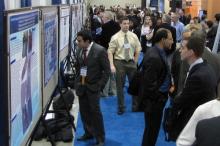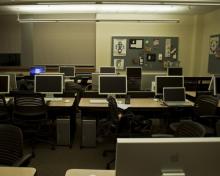I gotta say it – poster sessions are one of my favorite meeting venues.
Thronged with excited doctors who can hardly restrain themselves during the delicate balancing act of pointing out statistics and conclusions, all the while balancing plates of food and glasses of wine like the Cat in the Hat and his famous multitasking adventure with Meg and the goldfish.
Here are scientists just being themselves – taking pictures of friends proudly displaying their “babies,” unconcerned about microphones or accents, uninhibited by the formality of speaking before a crowd, congratulating the sharp conclusion, questioning the flawed method, pushing for the truth.
The sessions are deservedly popular- a glorious mash-up of crowd focused on having fun through the whirlwind of group mind. One question leads to another and another — with both investigators and listeners saying, “Wow, I hadn’t thought of that angle.”
And then there’s the ritual exchange of cards – the face-to-face interchange that forges new relationships. I hear it all the time: “I’m going to email you some data I think you can really use.” “I’m working on something similar – let’s get together later and see how we can work together.”
They might not be broad enough or profound enough to make it to a big session, but they’re often specific enough to solve a riddle that has plagued a doctor in his or her own practice. Nothing beats it when you see a proverbial light bulb switch on over someone’s head and then that person says “Wow, I have a patient with EXACTLY this issue! I’m going to go home and give this a try!”
In a nutshell, it’s what medicine is all about – standing on someone else’s shoulder to grab the formerly ungrabbable.
From a purely selfish perspective, these sessions often make for great stories. The pros ask questions that might never cross my mind, and whether relaxed by the convivial atmosphere or the free goodies, everyone is in a generous “information-sharing” mood that journalists don’t always encounter.
Contrast that to the digital poster sessions here at the summer meeting of the American Academy of Dermatology.
There’s the requisite big, cavernous room.
Subtract the papers on the wall, quadruple the number of empty computers, and you have some idea of the AAD's poster session at the summer meeting in Chicago. Photo by Flickr Creative Commons user Art as a weapon.
There’s a central podium with a TV screen made for displaying the poster.
There are rows and rows of computers, each with a chair in front.
And 90% of them are empty.
I visited twice yesterday, both times when an author I wanted to meet was scheduled to present data.
Once I was alone in the room.
Once there was one doctor, who told me this was the second “session” he’d attended – neither of which was graced by the author of the scheduled poster.
“I asked about it at the registration desk,” he said. “I was told it’s not mandatory for the presenter to attend. People can come in here any time and view all of the posters on screen.” The proctor in charge of the room told me only one presenter had shown up all day – and no one was there to hear her speak.
I checked it out. The program is easy to navigate. It brings up the poster in a series of PDF images. There’s even a link to email the presenter – although after you input all the data you get a message saying “Thank you. Your email will be delivered after the meeting concludes.”
In almost 10 years of medical reporting, this is the first 100% digital poster session I’ve attended, and I have to say it was a sad sight. I realize “green” is the new byword of our society – and computer presentations do save on printing costs for the giant poster and hundreds of handouts. But nothing can replace the human element of group mind – the electric conflagration that happens when the 10 trillion neurons in one brain start firing in tandem with 100 trillion more – and that’s just when 10 people are discussing the same work. Multiply it by the hundreds that typically attend these sessions and you can get some idea of the intellectual energy that fires up a room.
Not to go all metaphysical on you – but let’s just say that the law of the universe employs a different math than humans do. In the poster session, 1+1 does not just equal 2. It equals an infinity of thought.



